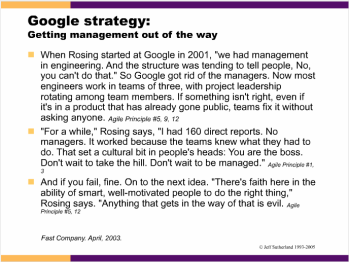|
|
Slide 18 - Tirando os gerentes do caminho
Em algumas ocasiões a gerência não sai do caminho. Vou contar sobre o que o Google fez. Eu não necessariamente recomendo isto, muitas empresas não podem fazer isto, mas quando Rosing (Wayne Rosing, vice-presidente de engenharia) começou a trabalhar no Google, os gerentes na engenharia estavam falando às pessoas o que fazer. Isto estava impedindo o progresso. Assim, ele os eliminou. Desta forma, ele passou a ter 160 pessoas reportando-se diretamente a ele. Ele as dividiu em equipes de três engenheiros e disse “vocês têm total responsabilidade!”. Ele os tornou autônomos. Isto funcionou porque os engenheiros sabiam o que fazer. Este foi um lance cultural, ele disse: “vocês são os chefes, não esperem ser gerenciados”. E se você falhar, está bem! Abrace a incerteza! Levante-se novamente e mova-se para a próxima idéia. A habilidade de pessoas felizes e bem motivadas para fazer a coisa certa é o que é mais importante. Fred Brooks em seu artigo “No silver bullet” (Não existe uma bala de prata), no final dos anos 80, disse que há apenas duas coisas que tornam o desenvolvimento de software realmente rápido: indivíduos bem afiados e permitir que o software evolva. Ele disse: “Se eu tiver uma especificação completa e três anos, eu não conseguiria construir o software mais rápido do que se eu deixasse que o mesmo evoluísse em seis meses sem especificação alguma”. Assim, sem especificações e agilidade é seis vezes melhor do que a grande especificação e o grande plano. Agora, dito isto, por que alguém quer a grande especificação e o grande plano? Quantos de vocês estão usando a grande especificação e o grande plano nesta sala? Ok, ao menos a metade de vocês! Imagine a oportunidade que vocês têm a frente! (risos) A primeira coisa que sabemos é que cerca de metade do que vamos desenvolver jamais será usado. Desta forma, seu maior foco na produtividade está em descobrir o que deve ou não ser feito. Porque isto irá permitir a economia de muito dinheiro e irá permitir muito mais lucro à sua empresa. E se você fizer isto da maneira correta, o cliente ficará realmente mais feliz. Quantos de vocês com o grande plano e o grande projeto sairão daqui e farão o que acabei de dizer? (alguém na platéia diz “Iremos tentar!”) O que eu conto nas sessões de treinamento e certificação de ScrumMasters, particularmente se isto acontece dentro de uma empresa, é: “Você não pode sair desta sala sem fazer alguma coisa com este conhecimento. Você simplesmente não pode! Você tem que mudar!”. Assim, quando você sair daqui vá diretamente para a equipe e replaneje tudo. Nós nos encontraremos amanhã no tutorial sobre Scrum e você pode usar seu exercício como exemplo, Ok? Alguém aqui está vindo para o tutorial de Scrum amanhã? Bem, venha com algumas idéias sobre a forma como você pretende fazer isto. Isto trará grandes exemplos para discutirmos em nosso tutorial. Sometimes management doesn't get out of the way. That's what Google did. I don't necessarily recommend this, most companies can't do it, but when Rosing started at Google managers on engineering were telling people what to do. And it was stopping progress. So he eliminated them. And then he had 160 direct reports. And he split them into teams of three engineers and he said “you guys are totally responsible!”, Ok? He made them autonomous. It worked because they knew what they had to do. And it set a cultural bid and he said “you are the boss, don't wait to be managed”. And, if you fail, fine! Embrace uncertainty! Take yourself up and move on to the next idea. The ability of smart, well motivated people to do the right thing is what is most important. Fred Brooks in his “No silver bullet” paper, in the late eighties, said there is only two things that make software go really fast: really sharp individuals and allowing an evolving of that software. He said “if I had a complete spec and three years, I couldn't build that software as fast as I could let it evolve with six months and no spec.”, Ok? So, no spec and agile is six times better than big spec and big plan. Now, given that, why would anyone want the big spec and the big plan, Ok? How many are using the big spec and the big plan in this room? Ok, at least half of you! Think of the opportunity ahead of you! (laughs) The first thing we know is that about half of what you've built will never be used. So, your major focus on productivity should be to figure out what that is and not do it. Because that is going to save you a lot of money and make your company a lot more profitable and, if you're doing it in the right way, the customer will be actually happier. How many of you with the big plan and the big project will gonna go out there and do there what I just said? (someone in the audience says “We will try!”) What I tell in the certified ScrumMaster training sessions, particularly if it is an in house session in the company is “you cannot walk out of this room without doing something knowing that. You just can't do it! You've got to change!” So when you go out of here go directly to the team and replan everything. And we were meeting tomorrow in the Scrum tutorial and we can use your exercise as examples, Ok? So, any of you coming to Scrum tutorial tomorrow? Well, come in with some ideas on how what you might do it. It would be great examples for discussion in the tutorial.
|






